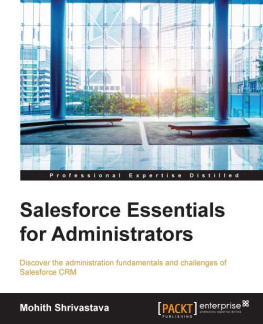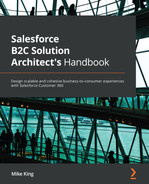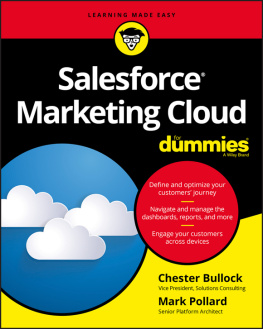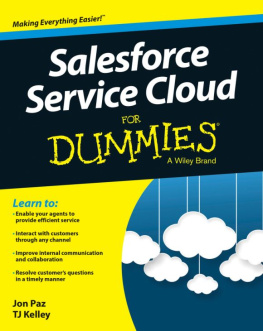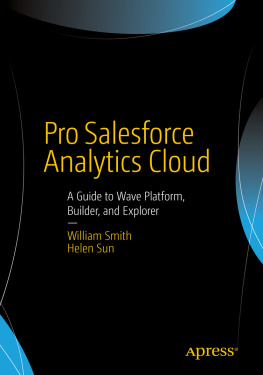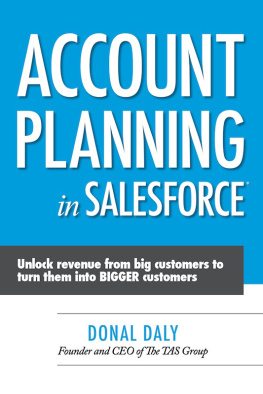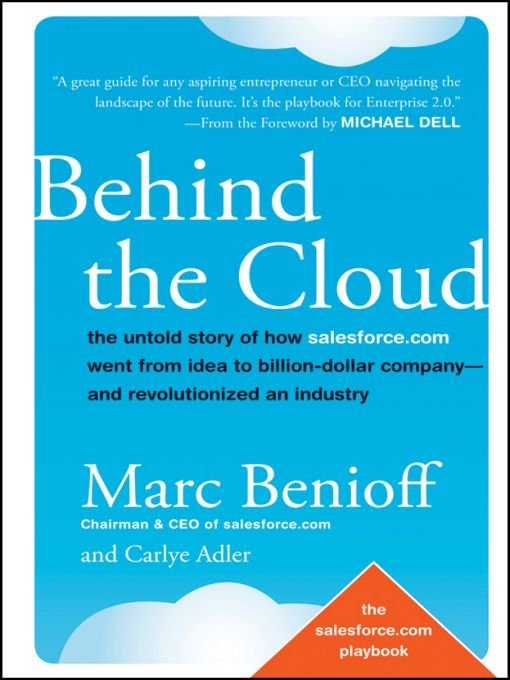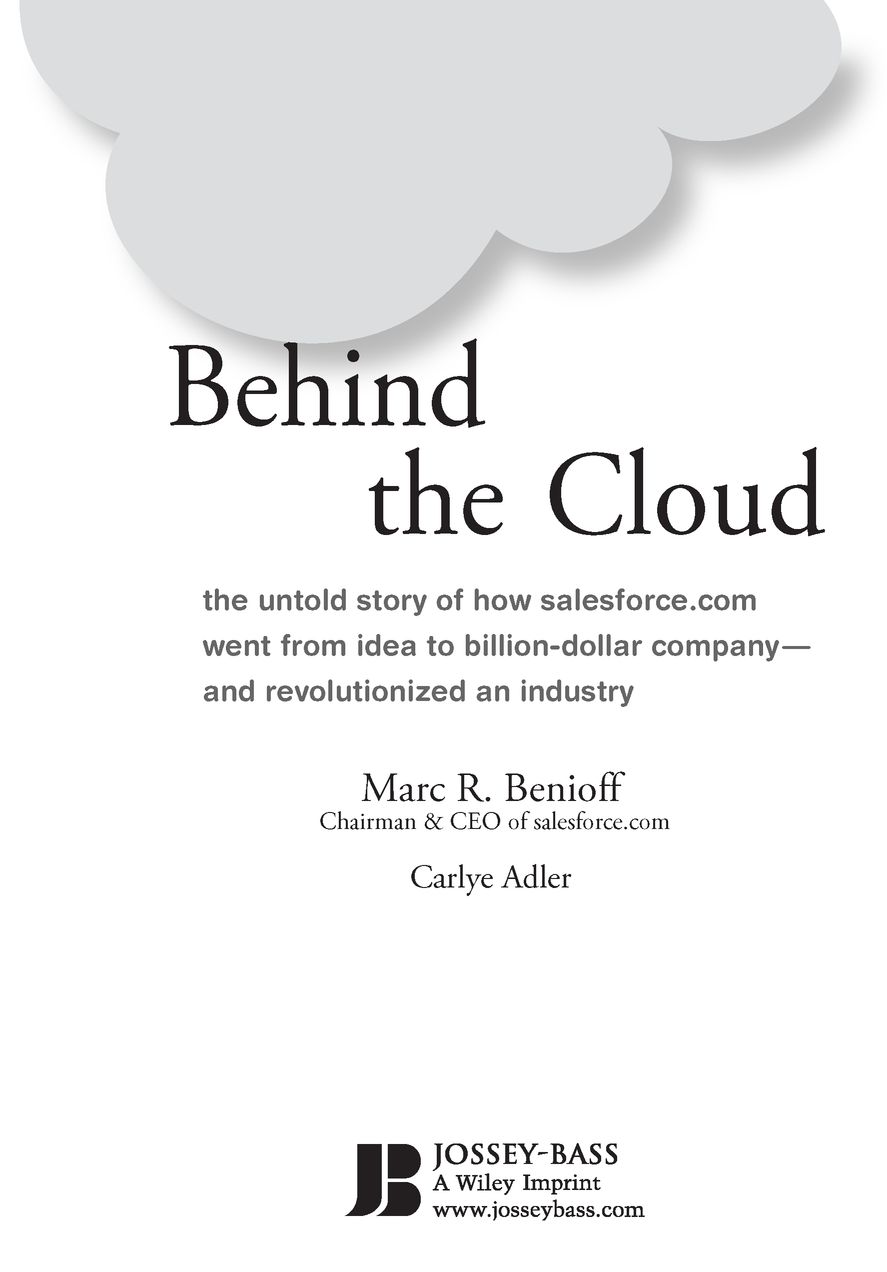Table of Contents
For Lynne and the salesforce.com employees, customers,
and investorswithout whose unconditional support
we would not be successful
Foreword
In 2001, in the midst of our previous economic meltdown, Marc Benioff came to me worried. Internet companies had evaporated overnight, and salesforce.com, a two-year-old company with a high proportion of dot-com customers, was ailing. Im scared about the future of my company, Marc said. We cant get venture capital. Im worried about survival.
It was a precarious time, but I knew then, as I know now, that economic shakeouts need not bode misfortune for technology companies. Not, at least, for innovative ones. Technology does not recognize economic recessions or depressions; it always continues. And, as all visionaries know, in chaos there is opportunity. I assured Marc that salesforce.com would last. This is your time, I said. You can do this.
I was bullish on salesforce.com and Marc, not because I have a crystal ball (though that certainly would be convenient), but because there was a need for change in the software industry and an audience ripening for salesforce.coms End of Software revolution. I had seen similar issues with affordability and accessibility plague the hardware industry when I started Dell.
Computers have long been a personal passion; growing up, I was fascinated with the machines but also struck by the inefficiencies in the industry, which required that we purchase computers from dealers, who bought them from distributors or manufacturers. Not only did that system yield a computer that cost four times the value of the parts inside, but it took so long that the machines were obsolete by the time customers got them. Buying direct from the source was an unprecedented idea in the industry, but it made common senseeven to a college student. The drive to implement simple new ideas and defy traditional ones has been the foundation of Delland the biggest reason our company has reaped huge rewards.
Salesforce.com sought to solve similar inefficiencies in the software industry. Enterprise software was exorbitantly expensive and onerous to implement, and, in the end, it didnt work very well. This was what enterprise customers came to expect. (Forget smaller customers; they couldnt even afford it.) Marc changed that reality when he used the Internet as a platform to deliver business software and reduce the risks and costs long associated with the client-server model. Salesforce.com made its service available to the masses, and it attentively and creatively engaged with its entire audience. It worked for the people who used the service (not only the folks paying for it), and it built what they requested. This earned salesforce.com an army of enthusiasts. And the companys focus on customer success forced all companies in the software industryand far beyondto rethink their models.
It certainly has inspired new thinking at Dell. Over the past few years, we committed to making some fundamental changes. We needed to refocus on providing the best customer experience, and we wanted to scale far beyond the commodity game and rapidly increase innovation. I went to Marc, who always seemed to be a machine for new ideas, and asked him, How can we innovate faster?
Marc told me about an internal networking technology they were using at salesforce.com to work with customers and create a feedback loop. This discussion led to IdeaStorm, an online community forum that we now use to engage our customers, elicit their ideas, and help determine which ones to put into practice. The site, which is like a live 24/7 focus group, has helped field ideas from more than ten thousand customers and allowed us to offer better products, such as notebooks with Linux OS preinstalled, backlit keyboards, and computers with more USB ports. At the time I am writing this, our customers have contributed 11,289 ideas, which have been promoted by other customers more than 651,394 times, with over 84,908 comments. IdeaStorm enables us to listen as never before, and it was a turning point in restoring our reputation as a customer-centric company.
At Dell, weve seen the benefits of having Marc and salesforce.com on our side. It has helped us align twenty thousand members of our global sales team, integrate thousands of our global channel partners, and rapidly evolve ideas. Thats why were now deploying the service across Dell and putting it at the center of every customer interaction.
Eight years ago, Marc had concerns about salesforce.coms survival, but of course it didnt just surviveit thrived. It has earned the distinction as the first dot-com listed on the New York Stock Exchange, and today it generates more than $1 billion in annual revenue. Salesforce.com changed corporate philanthropy by integrating giving into its business modeland sharing that model so that myriad companies have collectively flooded talent, products, services, and billions of dollars into their communities. Because salesforce.com offers employees an opportunity to make a difference, not just earn a paycheck, its known as one of the best places to work. Its original application has become the number-one hosted CRM service, and the company has established itself as the leader in the Software-as-a-Service (SaaS) industry it pioneered. And, through relentless focus, creativity, and passion, salesforce.com inspired an enterprise cloud computing industry. In short, the new and unconventional ideas that salesforce.com has evangelized have changed the way we do business and changed the world.
There has been a profound shift toward cloud computing in the past few years. Nearly every major public and private cloud is powered by Dell, and we are ecstatic to be running todays most exciting companies, including salesforce.com, Facebook, Microsoft, and many others. What motivates me most about this new way of computing is its potential for mass innovation. Now, for the first time, developers across the globe can access unlimited computing power. Its extraordinary that with a simple Web connection, anyone can build applications and deploy them to users everywhere.
By igniting the SaaS industry and then offering its Platform-as-a-Service, salesforce.com has spawned an ecosystem of countless new companies. It has offered large companies (such as Dell) and smaller companies just starting out valuable insights on how to innovate and succeed in the future.
In Behind the Cloud, Marc Benioff shares his unconventional advice in a clear and entertaining way. The lessons in this book are not exclusive to technology companies. They are applicable to all companies and all leaders who want to change the status quo and make a difference. Marc tells the inspiring story of how they did it at salesforce.com, and reveals how anyone else can, too. This is a great guide for any aspiring entrepreneur or CEO navigating the landscape of the future. Its the playbook for Enterprise 2.0.
We are in unprecedented economic times, but we are also in a new era of innovation. I tell anyone running a business today exactly what I told Marc when he was weathering a challenging climate: this is your time. You can do this. And, with the tools in this book, it will be easier and more rewarding than ever before.
Michael Dell
Founder, Chairman, and CEO of Dell
Introduction
This book is the story of how salesforce.com created a new industry, made our customers successful, and established itself as the market leader, all while making the world a better place. In this playbook, Ill share the strategies that Ive developed during my thirty years in the technology business, the last ten as the cofounder and CEO of one of the fastest-growing software companies in the world.


